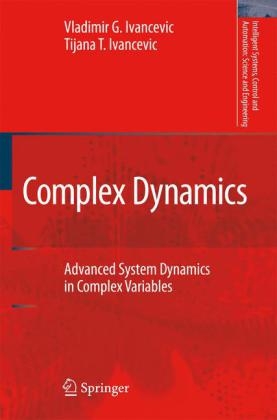
Complex Dynamics
Springer (Verlag)
978-90-481-7631-1 (ISBN)
- Keine Verlagsinformationen verfügbar
- Artikel merken
1 Introduction 1.1 Why Complex Dynamics ? 1.2 Preliminaries: Basics of Complex Numbers and Variables 1.2.1 Complex Numbers and Vectors 1.2.2 Complex Functions 1.2.3 Unit Circle and Riemann Sphere 1.3 Soft Introduction to Quantum Dynamics 1.3.1 Complex Hilbert Space 2 Nonlinear Dynamics in the Complex Plane 2.1 Complex Continuous Dynamics 2.1.1 Complex Nonlinear ODEs 2.1.2 Numerical Integration of Complex ODEs 2.1.3 Complex Hamiltonian Dynamics 2.1.4 Dissipative Dynamics with Complex Hamiltonians 2.1.5 Classical Trajectories for Complex Hamiltonians 2.2 Complex Chaotic Dynamics: Discrete and Symbolic 2.2.1 Basic Fractals and Biomorphs 2.2.2 Mandelbrot Set 2.2.3 Henon Maps 2.2.4 Smale Horseshoes 3 Complex Quantum Dynamics 3.1 Non-Relativistic Quantum Mechanics 3.1.1 Dirac's Canonical Quantization 3.1.2 Quantum States and Operators 3.1.3 Quantum Pictures 3.1.4 Spectrum of a Quantum Operator 3.1.5 General Representation Model 3.1.6 Direct Product Space 3.1.7 State-Space for n Quantum Particles 3.2 Relativistic Quantum Mechanics and Electrodynamics 3.2.1 Difficulties of the Relativistic Quantum Mechanics 3.2.2 Particles of Half-Odd Integral Spin 3.2.3 Particles of Integral Spin 3.2.4 Dirac's Electrodynamics Action Principle 4 Complex Manifolds 4.1 Smooth Manifolds 4.1.1 Intuition and Definition of a Smooth Manifold 4.1.2 (Co)Tangent Bundles of a Smooth Manifold 4.1.3 Lie Derivatives, Lie Groups and Lie Algebras 4.1.4 Riemannian, Finsler and Symplectic Manifolds 4.1.5 Hamilton-Poisson Geometry and Human Biodynamics 4.2 Complex Manifolds 4.2.1 Complex Metrics: Hermitian and Kahler 4.2.2 Dolbeault Cohomology and Hodge Numbers 4.3 Basics of Kahler Geometry 4.3.1 The Kahler Ricci Flow 4.3.2 Kahler Orbifolds 4.3.3 Kahler Ricci Flow on Kahler-Einstein Orbifolds 4.3.4 Induced Evolution Equations 4.4 Conformal Killing-Riemannian Geometry 4.4.1 Conformal Killing Vector-Fields and Forms on M 4.4.2 Conformal Killing Tensors and Laplacian Symmetry on M 4.5 Stringy Manifolds 4.5.1 Calabi-Yau Manifolds 4.5.2 Orbifolds 4.5.3 Mirror Symmetry 4.5.4 String Theory in 'Plain English' 5 Nonlinear Dynamics on Complex Manifolds 5.1 Gauge Theories 5.1.1 Classical Gauge Theory 5.2 Monopoles 5.2.1 Monopoles in R3 5.2.2 Spectral Curve 5.2.3 Twistor Theory of Monopoles 5.2.4 Nahm Transform and Nahm Equations 5.3 Hermitian Geometry and Complex Relativity 5.3.1 About Space-Time Complexification 5.3.2 Hermitian Geometry 5.3.3 Invariant Action 5.4 Gradient Kahler Ricci Solitons 5.4.1 Introduction 5.4.2 Associated Holomorphic Quantities 5.4.3 Potentials and Local Generality 5.5 Monge-Ampere Equations 5.5.1 Monge-Ampere Equations and Hitchin Pairs 5.5.2 The @-Operator 5.6 Quantum Mechanics Viewed as a Complex Structure on a Classical Phase Space 5.6.1 Introduction 5.6.2 Varying the Vacuum 5.6.3 Kahler Manifolds as Classical Phase Spaces 5.6.4 Complex-Structure Deformations 5.6.5 Kahler Deformations 5.6.6 Dynamics on Kahler Spaces 5.6.7 Interpretations 5.7 Geometric Quantization 5.7.1 Quantization of Ordinary Hamiltonian Mechanics 5.7.2 Quantization of Relativistic Hamiltonian Mechanics 5.8 K-Theory and Complex Dynamics 5.8.1 Topological K-Theory 5.8.2 Algebraic K-Theory 5.8.3 Chern Classes and Chern Character 5.8.4 Atiyah's View on K-Theory 5.8.5 Atiyah-Singer Index Theorem 5.8.6 The Infinite-Order Case 5.8.7 Twisted K-Theory and the Verlinde Algebra 5.8.8 Stringy and Brane Dynamics via K-Theory 5.9 Self-Similar Liouville Neurodynamics 6 Path Integrals and Complex Dynamics 6.1 Path Integrals: Sums Over Histories 6.1.1 Intuition Behind a Path Integral 6.1.2 Path Integral History 6.1.3 Standard Path-Integral Quantization 6.1.4 Sum over Geometries and Topologies 6.2 Complex Dynamics of Quantum Fields 6.2.1 Topological Quantum Field Theory 6.2.2 Seiberg-Witten Theory and TQFT 6.2.3 TQFTs Associated with SW-Monopoles 6.3 Complex Stringy Dynamics 6.3.1 Stringy Actions and Amplitudes 6.3.2 Transition Amplitudes for Strings 6.3.3 Weyl Invariance and Vertex Operator Formulation 6.3.4 More General Actions 6.3.5 Transition Amplitude for a Single Point Particle 6.3.6 Witten's Open String Field Theory 6.3.7 Topological Strings 6.3.8 Geometrical Transitions 6.3.9 Topological Strings and Black Hole Attractors 6.4 Other Applications of Path Integrals 6.4.1 Stochastic Optimal Control 6.4.2 Nonlinear Dynamics of Option Pricing 6.4.3 Nonlinear Dynamics of Complex Nets 6.4.4 Dissipative Quantum Brain Model 6.4.5 Cerebellum as a Neural Path-Integral 6.4.6 Topological Phase Transitions and Hamiltonian Chaos 6.4.7 Force-Field Psychodynamics 7 Quantum Gravity and Cosmological Dynamics 7.1 Search for Quantum Gravity 7.1.1 What Is Quantum Gravity? 7.1.2 Main Approaches to Quantum Gravity 7.1.3 Traditional Approaches to Quantum Gravity 7.2 Loop Quantum Gravity 7.2.1 Introduction to Loop Quantum Gravity 7.2.2 Formalism of Loop Quantum Gravity 7.2.3 Loop Algebra 7.2.4 Loop Quantum Gravity 7.2.5 Loop States and Spin Network States 7.2.6 Diagrammatic Representation of the States 7.2.7 Quantum Operators 7.2.8 Loop v.s. Connection Representation 7.3 Cosmological Dynamics 7.3.1 Hawking's Cosmology in 'Plain English' 7.3.2 Theories of Everything, Anthropic Principle and Wave Function of the Universe 7.3.3 Quantum Gravity and Black Holes 7.3.4 Generalized Quantum Mechanics 7.3.5 Anthropic String Landscape 7.3.6 Top-Down Cosmology 7.3.7 Cosmology in the String Landscape 7.3.8 Brane Cosmology 7.3.9 Hawking's Brane New World References Index
| Erscheint lt. Verlag | 30.11.2010 |
|---|---|
| Reihe/Serie | Intelligent Systems, Control and Automation: Science and Engineering ; 34 |
| Zusatzinfo | black & white illustrations |
| Verlagsort | Dordrecht |
| Sprache | englisch |
| Maße | 156 x 234 mm |
| Gewicht | 1141 g |
| Einbandart | Paperback |
| Themenwelt | Informatik ► Weitere Themen ► CAD-Programme |
| Mathematik / Informatik ► Mathematik ► Angewandte Mathematik | |
| Medizin / Pharmazie ► Physiotherapie / Ergotherapie ► Orthopädie | |
| Naturwissenschaften ► Physik / Astronomie ► Astronomie / Astrophysik | |
| Naturwissenschaften ► Physik / Astronomie ► Theoretische Physik | |
| Naturwissenschaften ► Physik / Astronomie ► Thermodynamik | |
| Technik ► Maschinenbau | |
| Technik ► Medizintechnik | |
| ISBN-10 | 90-481-7631-X / 904817631X |
| ISBN-13 | 978-90-481-7631-1 / 9789048176311 |
| Zustand | Neuware |
| Haben Sie eine Frage zum Produkt? |
aus dem Bereich


